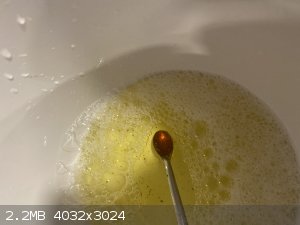
CwisGons - 1-11-2021 at 14:05
Hello everyone. This is a sort of update. I was using the technique in this paper to make 2,4-dinitrophenol:
https://moscow.sci-hub.st/4526/541af2b9f5fac168aa7aa854c7445...
I did the experiment and took the reaction mixture and added DCM. Once I did that, the resulting filtrant looked red, not yellow. I'm unsure why,
since the reaction mixture was yellow.
I will supply some pictures below. Although when I diluted the mixture in water, I got a yellow color. So what is happening?
Also, the product that I got when I distilled the DCM off was a red liquid and not yellow crystals. I even added magnesium sulfate because I thought
it was wet and that didn't help.So what should I do?


Tsjerk - 1-11-2021 at 15:41
I can't make sense out of the experiment nor the pictures. Can you describe what you did a bit more? For example the steps you took and the amounts of
reactants you used?
CwisGons - 1-11-2021 at 17:04
I used about 20 times the reactants in the study, which was 5.52 g sodium nitrite, 40 grams of 50% wetted silica, 1.8822 g phenol, and 9.28 g TCCA. I
mixed them together in a beaker while in an ice bath to prevent a high temperature. I then used a Dean Stark Apparatus to extract as much as I could
from the neat mixture with the least amount of DCM. The resulting DCM extraction resulted in a dark red liquid. I then distilled the DCM and ended up
with a deep red mixture.
Amos - 1-11-2021 at 18:23
You might still have a product in there, but nitroaromatics very commonly form reddish colors in the presence of impurities or at higher than neutral
pH. Some impurities also greatly reduce the melting point and therefore create a liquid mixture. There are a few ways you might try purifying this
product:
-Deprotonating the phenol using sodium hydroxide solution to form a water soluble sodium salt, removing insoluble impurities, and carefully adding
acid to see if it precipitates.
-Taking up the product in a polar solvent like ethanol, acetone, etc. and slowly mixing in water water to crash out your crystalline phenol. You might
try looking at the pH beforehand to see if acidification of the water is necessary to help your product separate.
-Taking up the product in a solvent in which it is not tremendously soluble, and patiently evaporating this solution to see if the product
crystallizes out slowly on its own. Chloroform or ether seem like the best candidates.
Bear in mind that this compound is slightly soluble in water, around 6g/L.
[Edited on 11-2-2021 by Amos]
Texium - 2-11-2021 at 05:39
You should wear gloves when handling this stuff. DNP is very toxic!
CwisGons - 2-11-2021 at 07:20
So I was also thinking of maybe adding a ton of acid(perhaps sulfuric acid or a lot of citric acid) and then running it through a deionization resin.
If my hypothesis is correct, if I lower the pH to about 2 or 3 (pKa of DNP is about 4.09), then most of the DNP will be in its neutral form due to
being protonated. Then the remaining deprotonated acid and other impurities are likely to be captured by the deionization resin, leaving mostly
neutral DNP. Would this work? If not, I'll also try the other methods provided by Amos.
I also apologize for not wearing gloves. It was stupid of me.
Tsjerk - 2-11-2021 at 10:30
The resin idea might work, but do you know what the impurities are? If it is phenol or mono-nitrophenol, those would also be protonated at pH 2-3. You
would only capture the product and sulfuric acid with the resin.
CwisGons - 2-11-2021 at 14:32
I see, alright then. But also the paper claims about 98% yield from this reaction. So I don't think that they could be high impurities. Neither phenol
or mononitrophenol are red colored. You could be right though.
draculic acid69 - 3-11-2021 at 02:50
Hope you are not making it for weightloss.
